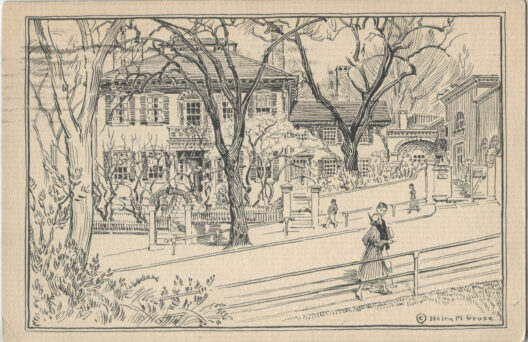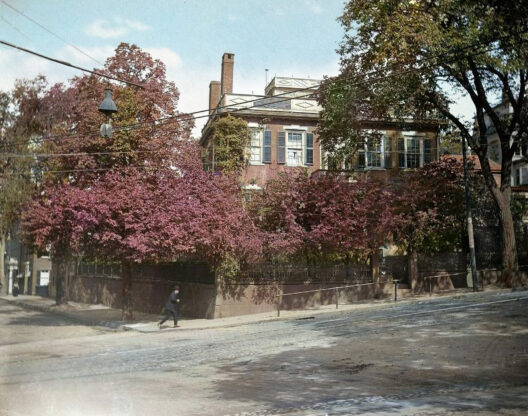This week in my regular ‘Picture Postals from Lovecraft’ slot, a picture via the archives of the Rhode Island School of Design. A side-on look at College Street on College Hill in Providence, as Lovecraft knew it in spring 1936 when he lived a little further up the hill.
Illustrator and Club member Helen M. Grose offers a postcard view across the street toward the Handicraft Club. This was a place well known to Lovecraft’s aunt and her friends. Lovecraft’s aunt lived here in 1927, and he sometimes harked back to its earlier days in letters and called it “the old Truman Beckwith house”. He enjoyed its “old-fashion’d terraced garden” and we know he took his friend Morton round it when he visited. Probably other visitors too, if he felt they would appreciate it. At Christmas 1933 Lovecraft was even to be found cheerily listening to carols sung in the Club’s courtyard…
… a stroll half-way down the hill to hear the carol-singing at the old Truman Beckwith mansion.
This 1936 drawing seems to confirm that (by mutual agreement and common sense) the university students traditionally used only one side of the street, while the residents had the other. Note also the upper ‘monitor’ roof section with small windows, looking similar to the one on Lovecraft’s last home at the top of the hill (he had access to it, and Brobst managed to work out how to open its door to the outside roof/railing).
The Club was one of thousands of examples of the tradition of free association, in what some have called the ‘little platoons’ of civic society. No permission from the state / church was required to establish or run a group of like-minded people of proven interests and skill. Nor did the state regulate who could or could not be admitted to membership, or require onerous and disfiguring accommodations to ‘the legal regulations’ etc. Not did the state send secret police to monitor the Club’s exhibitions for political correctness. Things were very different elsewhere in the world in 1936, where many people found themselves hurrying quickly through the murderous springtimes of the new political religion of Soviet Socialism or its heresy National Socialism.


